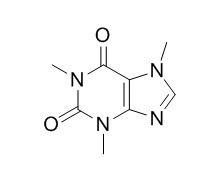Caffeine
Caffeine has anxiolytic-like activity, can have both positive and negative effects on anxiety. It inhibits glucose transport by binding at the GLUT1 nucleotide-binding site.
Inquire / Order:
manager@chemfaces.com
Technical Inquiries:
service@chemfaces.com
Tel:
+86-27-84237783
Fax:
+86-27-84254680
Address:
1 Building, No. 83, CheCheng Rd., Wuhan Economic and Technological Development Zone, Wuhan, Hubei 430056, PRC
Providing storage is as stated on the product vial and the vial is kept tightly sealed, the product can be stored for up to
24 months(2-8C).
Wherever possible, you should prepare and use solutions on the same day. However, if you need to make up stock solutions in advance, we recommend that you store the solution as aliquots in tightly sealed vials at -20C. Generally, these will be useable for up to two weeks. Before use, and prior to opening the vial we recommend that you allow your product to equilibrate to room temperature for at least 1 hour.
Need more advice on solubility, usage and handling? Please email to: service@chemfaces.com
The packaging of the product may have turned upside down during transportation, resulting in the natural compounds adhering to the neck or cap of the vial. take the vial out of its packaging and gently shake to let the compounds fall to the bottom of the vial. for liquid products, centrifuge at 200-500 RPM to gather the liquid at the bottom of the vial. try to avoid loss or contamination during handling.
Molecules.2019, 24(22):E4022
J Ethnopharmacol.2017, 209:305-316
J Microbiol Biotechnol.2024, 35:e2408022.
Biochemistry.2018, 57(40):5886-5896
Research Square2020, doi: 10.21203.
Exp Parasitol.2018, 194:67-78
Bioengineering2023, 10(10), 1113.
Horticulturae2020, 6(4),76.
Wageningen University & Research2018, January 2018
Antioxidants.2022, 11(3):592.
Related and Featured Products
Am J Physiol Cell Physiol. 2015 Feb 25
Caffeine inhibits glucose transport by binding at the GLUT1 nucleotide-binding site.[Pubmed:
25715702]
Glucose transporter 1 (GLUT1) is the primary glucose transport protein of the cardiovascular system and astroglia. A recent study proposes that Caffeine uncompetitive inhibition of GLUT1 results from interactions at an exofacial GLUT1 site. Intracellular ATP is also an uncompetitive GLUT1 inhibitor and shares structural similarities with Caffeine, suggesting that Caffeine acts at the previously characterized endofacial GLUT1 nucleotide-binding site.
METHODS AND RESULTS:
We tested this by confirming that Caffeine uncompetitively inhibits GLUT1-mediated 3-O-methylglucose uptake in human erythrocytes [Vmax and Km for transport are reduced fourfold; Ki(app) = 3.5 mM Caffeine]. ATP and AMP antagonize Caffeine inhibition of 3-O-methylglucose uptake in erythrocyte ghosts by increasing Ki(app) for Caffeine inhibition of transport from 0.9 ± 0.3 mM in the absence of intracellular nucleotides to 2.6 ± 0.6 and 2.4 ± 0.5 mM in the presence of 5 mM intracellular ATP or AMP, respectively. Extracellular ATP has no effect on sugar uptake or its inhibition by Caffeine. Caffeine and ATP displace the fluorescent ATP derivative, trinitrophenyl-ATP, from the GLUT1 nucleotide-binding site, but d-glucose and the transport inhibitor cytochalasin B do not. Caffeine, but not ATP, inhibits cytochalasin B binding to GLUT1. Like ATP, Caffeine renders the GLUT1 carboxy-terminus less accessible to peptide-directed antibodies, but cytochalasin B and d-glucose do not.
CONCLUSIONS:
These results suggest that the Caffeine-binding site bridges two nonoverlapping GLUT1 endofacial sites-the regulatory, nucleotide-binding site and the cytochalasin B-binding site. Caffeine binding to GLUT1 mimics the action of ATP but not cytochalasin B on sugar transport. Molecular docking studies support this hypothesis.
Neuroscience. 2015 Feb 11. pii: S0306-4522(15)00146-3.
Anxiolytic-like, stimulant and neuroprotective effects of Ilex paraguariensis extracts in mice.[Pubmed:
25681522]
Yerba-mate (Ilex paraguariensis St. Hil.) is the most used beverage in Latin America with approximately 426 thousand of tons consumed per year. Considering the broad use of this plant, we aimed to investigate the anxiety-like and stimulant activity of both the hydroethanolic (HE) and aqueous (AE) extracts from leaves of I. paraguariensis.
METHODS AND RESULTS:
Swiss mice were treated with I. paraguariensis HE or AE chronically or acutely, respectively, followed by evaluation in the elevated plus-maze (EPM; anxiety-like paradigm), open field (OF; locomotor activity) or the step-down avoidance task (memory assessment). Following behavioral protocols the brains were collected for evaluation of acetylcholinesterase (AChE) activity ex vivo. Chronic treatment with HE induced an anxiolytic-like effect and increased motor activity besides augmented AChE activity. Additionally, acute treatment with AE prevented the scopolamine-induced memory deficit in the step-down avoidance task.
CONCLUSIONS:
Overall, our results indicate the importance of the I. paraguariensis-induced CNS effects, since it is a widely used nutraceutical.
We have reported anxiolytic, stimulant and neuroprotective effects for this plant species. These effects are potentially modulated by the cholinergic system as well as by Caffeine.
Reprod Biol. 2015 Mar;15(1):20-6.
Caffeine stimulates in vitro pituitary LH secretion in lipopolysaccharide-treated ewes.[Pubmed:
25726373]
The study was designed to determine the effects of Caffeine on luteinizing hormone (LH) secretion and gene expression of Caffeine-associated receptors in anterior pituitary (AP) explants obtained from saline- and lipopolysaccharide (LPS)-treated ewes.
METHODS AND RESULTS:
Animals had been treated with LPS or saline daily for seven days. Three hours after the last injection of LPS/saline, the AP were collected and divided into four explants. The explants were incubated with: 1/medium-199 (control explants), 2/gonadotropin-releasing hormone (GnRH; 100 pmol/mL; a positive control), 3/Caffeine (10 mmol/L), or 4/GnRH+Caffeine. Caffeine stimulated (p<0.05) LH release by explants from both saline (19.7 vs. control 12.6 ng/mg) and LPS (28.3 vs. control 13.9 ng/mg) treated animals. The effect of Caffeine on LH secretion was stronger in the LPS-treated group than in saline-treated group, and the observed LH release was similar to that induced by GnRH alone (27.2 ng/mg). Caffeine increased (p<0.05) LHβ gene expression only in explants from LPS-treated animals.
CONCLUSIONS:
In conclusion, the results of the present study demonstrated a stimulatory in vitro effect of Caffeine on LH secretion by ovine pituitary explants. The potency of the Caffeine-induced LH secretion was affected by in vivo treatment of the animals with endotoxin.



